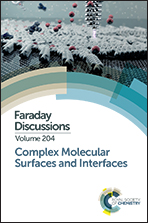Sequential nested assembly at the liquid/solid interface†
Abstract
Studying the stepwise assembly of a four component hybrid structure on Au(111)/mica, the pores of a hydrogen bonded bimolecular network of 3,4,9,10-perylenetetracarboxylic diimide (PTCDI) and 1,3,5-triazine-2,4,6-triamine (melamine) were partitioned by three and four-armed molecules based on oligo([biphenyl]-4-ylethynyl)benzene, followed by the templated adsorption of either C60 fullerene or adamantane thiol molecules. The characterisation by ambient scanning tunneling microscopy (STM) reveals that the pore modifiers exhibit dynamics which pronouncedly depend on the molecular structure. The three-armed molecule 1,3,5-tris([1,1′-biphenyl]-4-ylethynyl)benzene (3BPEB) switches between two symmetry equivalent configurations on a time scale fast compared to the temporal resolution of the STM. Derivatisation of 3BPEB by hydroxyl groups substantially reduces the switching rate. For the four-armed molecule configurational changes are observed only occasionally. The observation of isolated fullerenes and small clusters of adamantane thiol molecules, which are arranged in a characteristic fashion, reveals the templating effect of the trimolecular supramolecular network. However, the fraction of compartments filled by guest molecules is significantly below one for both the thermodynamically controlled adsorption of C60 and the kinetically controlled adsorption of the thiol with the latter causing partial removal of the pore modifier. The experiments, on the one hand, demonstrate the feasibility of templating by nested assembly but, on the other hand, also pinpoint the requirement for the energy landscape to be tolerant to variations in the assembly process.
- This article is part of the themed collection: Complex Molecular Surfaces and Interfaces


 Please wait while we load your content...
Please wait while we load your content...